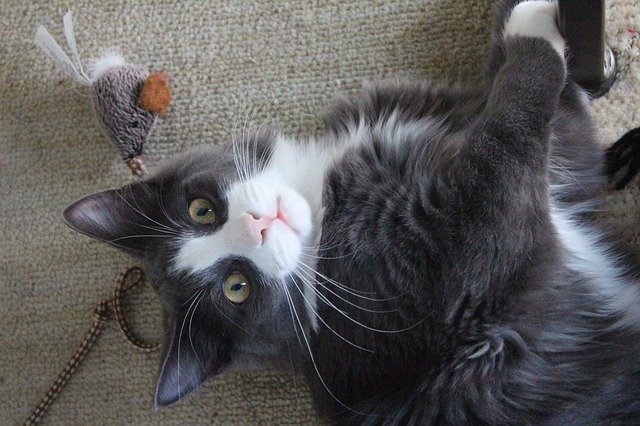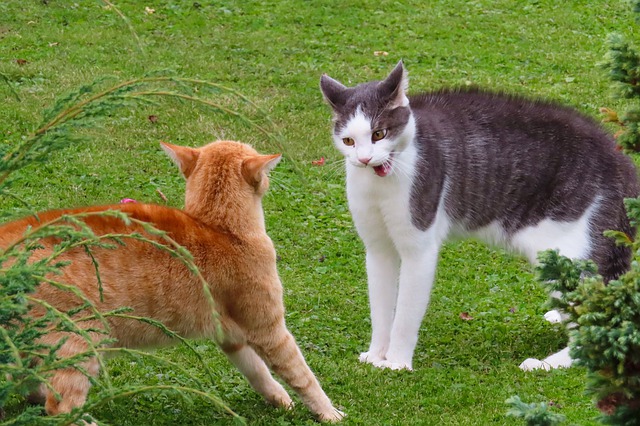Cat Aggression Problems Solved
.
Understanding Cat Aggression Problems: Summary
- Cats have claws and jaws and sometimes enjoy using them! Cat aggression can be playful but it can be unwanted aggressive or fearful behaviour too.
- Management of the cat anxiety issue involves redirecting the cats energy on to more appropriate activities. A vet check may be necessary too.
- Long term solutions involve gradual introductions to other animals and working with the cat’s dislikes to turn these into calmer situations
Why cats are aggressive
Cat aggression is natural behaviour at times but can be unwanted. Have you ever been attacked by a cat? Not pleasant! There are many reasons for a cat attack. Here are the main causes of feline aggressive behaviour. Try to work out why your cat is displaying aggressive behaviours.
The playful cat
These cats are extremely playful, using their effective weapons (teeth and claws)! Often these attack cats are bright, intelligent animals, looking for stimulation. Play, however, can turn to aggression.
The redirected aggressor
If your cat is feeling angry or fearful of a situation and you interrupt them, they may lash out at you. These attack cats are not intentionally trying to hurt you.
The anxious cat
These felines need to defend themselves from real or perceived threats. Fearful cats will turn to aggression when they cannot escape the threat. Cat anxiety is a common cause of cat aggression.
The ‘romancer’
Aggression is a natural part of the cats’ mating rituals. Since most owners wish a pet cat, not a queen or stud, few of us encounter this behaviour. There may, however, be remnants of this behaviour still displayed in desexed cats.
The hunter
There is a hunter in every cat. This is natural but many owner do not wish their cat to hunt wildlife.
Follow these tips for reducing your cat’s hunting behaviour.
The unwell cat
Pain or medical conditions can cause cats to be aggressive, when they would otherwise be placid pussycats. A vet check is necessary.

How to tell that your cat is about to attack
Have a look at your cat’s body language. Before they attack they will often push their whiskers forward on their face. Of course, you’d have to be close enough to your cat to see this happening.
If cats are afraid and attacking out of fear, you may see them crouch low and their ears may be drawn back.
If your cat is more playful, you may see them crouch, ready to pounce. Their tail may wave from side to side. Cat play can sometimes be difficult to distinguish from a cat fight! See how here.
How can we stop a cat being aggressive?
These tips from Dr Jo Righetti, animal behaviourist, may help with most types of cat aggression problems.

Cat to Cat Aggression in Multi-cat Households
In multi-cat households, one cat will often start to “bully” the other – chasing, not allowing access to the litter tray, just being annoying. Try these tips to help your cats get along and reduce cat aggression problems.
1. Give all cats in the household space. Space to find a bed of their own. A place to sit and view their world. Space and safety to toilet. Cats often use time partitioning to separate territory (yours in the morning, mine at night!)
2. Where possible, let the cats decide who is boss. You interfering will only make things worse. Only interfere if someone is being hurt or their freedom severely restricted.
3. Give each cat your individual attention. If necessary, ensure other cats are out of the room.
4. Play with your cats so that the bully does not need to use their energy in terrorising the other cat.
5. Train the bully cat and occupy their body and mind in learning tricks.
Always think carefully before you introduce another cat into your household. Wanting them to be friends may be too optimistic. A harmonious and quiet household should be your goal.
When does cat play become a catfight?
Frequently asked questions about cat aggression
Why does my cat bite my nose?!
Your cat gets your attention when he bites you (it would be hard to ignore!). Try to give your cat attention when they are calm and have something else, more appropraite, to stick in his mouth when he is likely to bite you.
Why is my cat attack my other cat? He looks scared!
Your cat may attack due to playfulness, or due to fear. Work on positive introductions between your cat to reduce fear.
Why does my cat attack me at night?
Your cat probably has an excess of energy in the evening that you need to give an outlet for. Try playing with your cat in the early evening, then give them time to wind down before bed.
About the author: Dr Jo Righetti
Dr Jo Righetti is an animal behaviourist, helping people with pets. With a PhD in behaviour, a diploma in counselling and over 20 years experience in business Pet Problems Solved, Dr Jo understand pets and communicates here knowledge in a motivational manner. Jo lives with cats!
More cat behaviour articles…
- Pets and water sprays: No way!Pets and water sprays People often tell me that they use a water spray to correct their pet’s behaviour. They say it works,
- Cats use of litter box is determined by sight, not scentCats use of litter box determined by sight, not scent You might think your cat’s litter box is clean , even if they
- How to Keep Pets Calm in Stressful SituationsAll pets get stressed at times and some are in a constant state of anxiety, so it helps to know how to keep
- Australia’s cats kill 650 million reptiles a year!At Pet Problems Solved, we LOVE cats. But cats hunt, it’s inevitable. Indoors they hunt toys, food or us. Outdoors they hunt wildlife.
- Ask Dr Jo – Your Cat Q&As (With adorable Cats to watch!)Ask Dr Jo – Your Cat Q&As in the Fancy Feast Lounge Enjoy our cat videos, and get your feline questions answered, in
- Top 10 Problem Pets – and Problem Pet BehaviourAre you frustrated, angry or puzzled y your pet’s behaviour? Here’s your guide to the top 10 problem pets and problem cat behaviour and dog behaviour…
- Cleaning Up Pet Toileting AccidentsCleaning up pet toileting accidents Tips for Cleaning up Pet Pee and Poo Toileting Problems Around Your Home ‘Accidents’ around the home need
More cat reading
The importance of pet play
How and why your cat purrs
Cats’ preferred litter types
What your cat wants you to know about their eating habits
Why cats attack
About this website
Information here is written by Dr Jo Righetti, PhD Animal Behaviourist and is based on scientific research and over 20 years experience of working with people and pets.